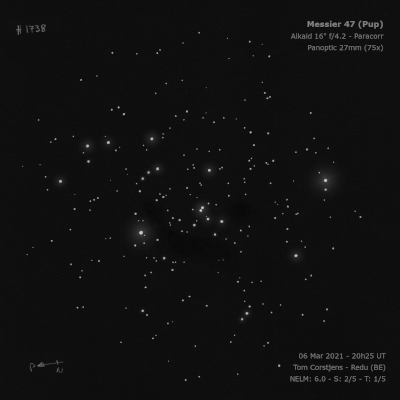
Caroline Herschel independently discovered M47 = NGC 2422 = H VIII-38 = h459 = h3088 on 26 Feb 1783. William Herschel found the cluster again on 4 Feb 1785 (sweep 366) and recorded "a very coarsely scattered cluster of several vL and other different sized stars." His summary description (including a second observation) reads "a cluster of pretty compressed large and small stars, round, above 15' diameter." From the Cape of Good Hope, John Herschel wrote, "a very large, pretty rich splendid cluster, which more than fills the field. Place of the chief star a find double star."
Giovanni Hodierna probably was the first to discover M47 before 1654 and simply recorded "a Nebulosa between the two dogs". Charles Messier rediscovered it 117 years later on 19 Feb 1771, though he clearly made an error as there is nothing at his position. Messier's missing object was assigned GC 1594 and NGC 2478. In 1959, Canadian amateur T.F. Morris identified M47 as identical to NGC 2422. See notes for NGC 2478.
200/250mm - 8" (11/5/83): very bright, large but scattered, includes STF 1121 = 8/8 at 7" near core and STF 1120 on west side, many colored stars.
300/350mm - 13.1" (11/5/83): very bright, very large, fairly rich, impressive. Includes double stars STF 1121 = 7.9/7.9 at 7" in the center and STF 1120 = 5.7/9.6 at 20" on the west side. Easy naked-eye object in a dark sky.
400/500mm - 18" (3/2/08): this naked-eye cluster was stunning at 73x (31 Nagler), though at 30' diameter it was too spread out for higher powers. The stars are arranged in beautiful chains and groups. The brightest half-dozen stars are in a 10' subgroup in the center including a striking white double star (STF 1121 = 7.0/7.3 at 7") that is is surrounded by many stars in chains and loops. The brightest star on the west side is a wide, unequal double (5.7/9.7 at 20"). Perhaps 200 stars are scattered around at low power.
Notes by Steve Gottlieb